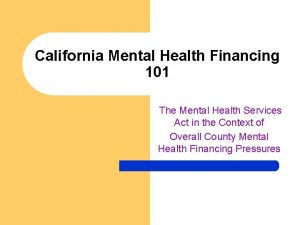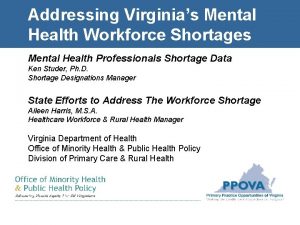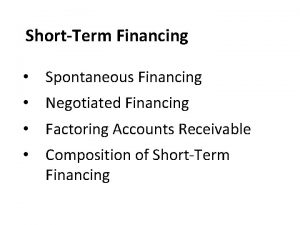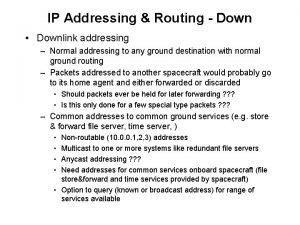Recommendations for Addressing Californias Mental Health Financing Challenges






















- Slides: 22

Recommendations for Addressing California’s Mental Health Financing Challenges Ann Arneill-Py, Ph. D, Executive Officer CA Mental Health Planning Council Mental Health Services Oversight and Accountability Commission Meeting April 26, Planning 2006 CA Mental Health Council

Overview Long-standing challenges Federal advocacy opportunities State reforms Most recommendations result from year -long effort to study structural problems with financing of mental health system and develop recommendations CA Mental Health Planning Council 2

Long-Standing Challenges Realignment The uninsured The effect of underfunding on the mental health workforce CA Mental Health Planning Council 3

Realignment Equity l l l Per capita funding varies greatly among counties Such variability results in less access to services in poorly funded counties Mechanisms to correct that variability are slow to affect change l MHSA: full service partnerships funded at consistent levels, but only serving small proportion of clients Structural problems with the distribution formula so that entitlements, such as child welfare, foster care, and IHSS, have first call on the Sales Tax Growth Account l End result is that Mental Health Subaccount will receive no sales tax growth revenue foreseeable future CA Mental Health Planning Council 4

The Uninsured 46 million persons uninsured in the United States (15. 4%) 7. 1 million in California 80% are adults; Medi-Cal and Healthy Families help meet the needs of children The erosion of realignment funding means that resources for serving indigent adults are becoming very scarce Realignment funding as a revenue source decreases when the economy is bad, which is the same time the number of uninsured would increase due to increased unemployment CA Mental Health Planning Council 5

Effect of Underfunding the on Mental Health Work Force Vacancy rates averaging 25% for major occupations Counties and community-based agencies concerned about being able to implement CSS plans Inadequate salaries compared to other county departments, other state departments, and other occupations major barrier to recruiting and retaining a sufficient workforce CA Mental Health Planning Council 6

Federal Advocacy Medicaid reductions proposed in FFY 2007 budget proposal Medicare reforms Mental health parity issues CA Mental Health Planning Council 7

Proposed Medicaid Reductions—FFY 2007 “Clarifying” allowable services that can be claimed as Medicaid rehabilitation services l l Projected to save $225 M in FFY 2007 and $2. 3 B over 5 years Could decimate Rehab Option, trying to shift all responsibility to state level Potential to implement administratively—advocacy needed with Administration and Congress Important because Rehab Option expanded range of psychosocial rehabilitation services available, allowed a broader range of occupations to provide services, and more locations at which services could be provided CA Mental Health Planning Council 8

Medicare Reforms Parity for outpatient psychotherapy services l 50% co-payment for psychotherapy while only a 20% co-payment is required for outpatient health services Expand coverage for community-based services—excluded services: l l Crisis or ACT teams, psychosocial rehabilitation, intensive case management Proven approaches to prevent inappropriate institutionalization Expand specialty inpatient psychiatric care coverage from lifetime limitation of 120 days CA Mental Health Planning Council 9

Mental Health Parity Federal Issues l National Mental Health Parity Act of 1996 l l Established parity between mental health and medical health insurance on annual and lifetime dollar limits Sunset extended through December 2006 Advocates still trying to pass Wellstone Mental Health Equitable Treatment Act of 2003— parity for co-payment, deductibles, visit limits New threat—S. 1955 would override state insurance mandates, allowing insurers to circumvent state parity laws l Headed for Senate floor vote first week of May CA Mental Health Planning Council 10

Mental Health Parity Goals of State Parity Statute Improve access to and quality of mental health services for persons with SMI and SED l Decrease financial burden on public mental health system l End discriminatory practices in provision of mental health services l Reduce stigma associated with mental illness and delivery of mental health services l CA Mental Health Planning Council 11

Mental Health Parity DMH Report—Mental Health Parity: Barriers and Recommendations http: //www. dmh. ca. gov/Reports/Legislative/docs/legreport. pdf Example of major State issues l l l Lack of clarity about scope of covered services Problems with obtaining service authorization Access issues l l l Problems obtaining information about benefits “Phantom providers”—consumers cannot find qualified providers Public mental health system cannot easily obtain reimbursement for consumers with private insurance for whom it provides mental health services CA Mental Health Planning Council 12

Mental Health Parity Potential Solutions—California Coalition for Mental Health taking the lead l Work Group to meet to discuss next steps, potentially including Legislative solutions to increase the enforcement options of the Department of Managed Health Care l Regulatory options—changes to regulations for implementing state mental health parity statute have been pending for a long time l CA Mental Health Planning Council 13

State Reforms Aligning Medi-Cal reimbursement requirements with recovery philosophy Implementing evidence-based practices Promoting community-based services CA Mental Health Planning Council 14

Critical Guidance for State Reforms All mental health services should be client and family driven and strengths-based, building on a model that incorporates a recovery/wellness philosophy Care should be provided in a culturally and linguistically competent way with sensitivity and awareness to the person’s culture, race, ethnicity, language, gender, sexual orientation, religious/spiritual beliefs, and socio-economic status There should be no disparities for individuals or groups in accessibility, availability, or quality of mental health services provided CA Mental Health Planning Council 15

Aligning Medi-Cal Reimbursement Requirements with the Recovery Philosophy Basic principle of financial reform: financial structure and incentives must align with system outcomes—e. g. , providing recovery-oriented services Goal: every person/family would have a person/family-centered, recovery/resiliency oriented, culturally appropriate plan that would maximize Medi-Cal reimbursement CA Mental Health Planning Council 16

Medi-Cal Reimbursement and Recovery Work Group convened: DMH, CIMH, MHPs, private providers, consumers, family members Emerging sense that goal might be achieved within current federal statutory framework and state regulations Work to be done to clarify state policies and provide examples to meet state requirements Additional training needed to implement recovery-oriented treatment planning CA Mental Health Planning Council 17

Implementing Evidencebased Practices IOM definition: integration of the best research evidence with clinical expertise and patient values CIMH adaptation: Values-driven EBP l Practices that reflect the key values of the CA stakeholder community—such as recovery/resilience and cultural competence—and which are supported by an identified level of scientific evidence CA Mental Health Planning Council 18

Importance of EBPs Cost-effective l l Continue expenditures on programs and services of proven effectiveness Discontinue expenditures on programs that do not work Examples l l Cal. MEND—mental health care management program to include consumer education and medication algorithms SAMHSA toolkits—ACT; Illness, Management and Recovery; Family Psychoeducation; Co-occurring Disorders: Integrated Dual Disorders Treatment CA Mental Health Planning Council 19

Promoting Community-based Services Following lessons learned from wraparound programs for children and youth Expanding availability of affordable housing l Housing for California’s Mental Health Clients: Bridging the Gap http: //www. dmh. ca. gov/MHPC/docs/Housing-MHClients. pdf l Importance of MHSOAC’s Housing Initiative Focus on transitioning clients out of institutions, e. g. , IMDs Use MHSA to expand the number of counties with Older Adult Systems of Care l Our recent study found that only 10 out of 38 (26%) responding counties had OASOC CA Mental Health Planning Council 20

Conclusion Long-standing challenges remain Opportunities for federal advocacy are significant and should be pursued, especially to prevent adverse consequences to proposed Medicaid reductions State reforms can continue to bring positive results for clients and families CA Mental Health Planning Council 21

Contact Information Ann Arneill-Py, Ph. D, Executive Officer CA Mental Health Planning Council 1600 9 th Street Sacramento, CA 95814 (916) 445 -1198 Ann. Arneill-Py@dmh. ca. gov CA Mental Health Planning Council 22
 Grade californias vaccine
Grade californias vaccine 4 regions of california
4 regions of california Flat addressing vs hierarchical addressing
Flat addressing vs hierarchical addressing Mental health and mental illness chapter 20
Mental health and mental illness chapter 20 Mental health coping skills jeopardy
Mental health coping skills jeopardy Chapter 25 lesson 4 physical and mental challenges
Chapter 25 lesson 4 physical and mental challenges Key issue 3 why do some places face health challenges
Key issue 3 why do some places face health challenges Kontinuitetshantering
Kontinuitetshantering Typiska drag för en novell
Typiska drag för en novell Tack för att ni lyssnade bild
Tack för att ni lyssnade bild Vad står k.r.å.k.a.n för
Vad står k.r.å.k.a.n för Varför kallas perioden 1918-1939 för mellankrigstiden
Varför kallas perioden 1918-1939 för mellankrigstiden En lathund för arbete med kontinuitetshantering
En lathund för arbete med kontinuitetshantering Kassaregister ideell förening
Kassaregister ideell förening Personlig tidbok
Personlig tidbok Anatomi organ reproduksi
Anatomi organ reproduksi Förklara densitet för barn
Förklara densitet för barn Datorkunskap för nybörjare
Datorkunskap för nybörjare Tack för att ni lyssnade bild
Tack för att ni lyssnade bild Mall debattartikel
Mall debattartikel För och nackdelar med firo
För och nackdelar med firo Nyckelkompetenser för livslångt lärande
Nyckelkompetenser för livslångt lärande Påbyggnader för flakfordon
Påbyggnader för flakfordon











































